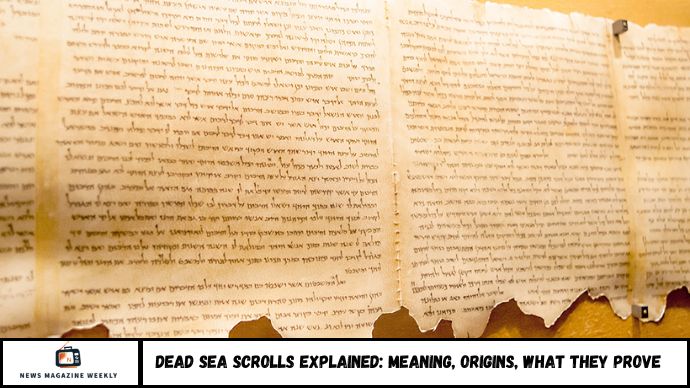The Dead Sea Scrolls are among the most important archaeological discoveries of the 20th century. Found near the ancient settlement of Qumran, these ancient Jewish texts date from the 3rd century BCE to the 1st century CE. In this article, we’ll explore what the scrolls are, where they were found, why they matter, and what they prove about ancient religion, history, and biblical accuracy.
Introduction: A Discovery That Shook the Ancient World
In 1947, a Bedouin shepherd searching for a lost goat stumbled into a cave near the Dead Sea. What he found wasn’t just pottery—it was history sealed in scrolls. This unintentional discovery led to a series of excavations across 11 caves, revealing over 900 ancient manuscripts, some more than 2,000 years old.
But what exactly are the Dead Sea Scrolls, and what do they tell us? Scholars, theologians, and historians have spent decades trying to decipher their meaning—and the results have changed the way we view biblical texts, Second Temple Judaism, and the origins of Christianity.
What Are the Dead Sea Scrolls?
The Dead Sea Scrolls are a collection of Jewish manuscripts written mostly in Hebrew, with some in Aramaic and Greek. They include:
- Biblical texts (partial copies of almost every Old Testament book)
- Apocryphal works not found in the Hebrew Bible
- Sectarian writings likely authored by the Essenes, a Jewish sect
Key Facts:
- Date Range: 250 BCE – 70 CE
- Number of Scrolls/Fragments: Over 900
- Languages: Hebrew, Aramaic, Greek
- Material: Parchment, papyrus, copper
- Location Found: 11 caves near Qumran, West Bank
What Do the Scrolls Prove?
The Dead Sea Scrolls don’t “prove” one single idea, but they provide vital evidence in several areas:
1. Preservation of Biblical Texts
The scrolls contain the earliest known copies of the Hebrew Bible, including books like Isaiah, Psalms, and Deuteronomy.
- Comparison with modern Bibles shows remarkable consistency—some passages are nearly identical to those in today’s texts.
- Proves: The stability and accuracy of biblical transmission over millennia.
2. Diversity of Ancient Jewish Thought
The scrolls reflect a wide variety of beliefs and interpretations:
- Different views on law, messianism, and temple worship.
- Writings from the Essenes indicate they rejected the mainstream Jerusalem priesthood.
- Proves: There was no single unified Judaism in the Second Temple period.
3. Insight Into the Origins of Christianity
Several scrolls mention ideas like a coming Messiah, resurrection, and end-times prophecies, echoing New Testament themes.
- Proves: These concepts existed before Jesus, possibly influencing early Christian thought.
4. Daily Life and Law in Ancient Judea
Many texts are not religious but legal, reflecting everyday concerns—divorce, ritual purity, and community discipline.
- Proves: The scrolls are a valuable social record, not just religious scripture.
Who Wrote the Dead Sea Scrolls?
Most scholars believe the Essenes, a Jewish sect living in the nearby settlement of Qumran, wrote the majority of the scrolls.
Supporting Evidence:
- Archaeological remains of Qumran include ritual baths, scriptoriums, and communal dining halls.
- Sectarian texts match descriptions of Essene practices by historians like Josephus.
Some scrolls may have come from other Jewish groups fleeing Jerusalem during Roman occupation, adding to the diversity of ideas in the collection.
Why the Dead Sea Scrolls Matter Today
- They bridge the gap between ancient oral traditions and modern written texts.
- They clarify how Jewish beliefs evolved in the time just before and during early Christianity.
- They validate the historical reliability of much of the Old Testament.
- They challenge assumptions about religious uniformity in ancient times.
FAQs
1. What are the Dead Sea Scrolls?
They are ancient Jewish manuscripts found near the Dead Sea, dating from 250 BCE to 70 CE.
2. When and where were they discovered?
They were first discovered in 1947 in Qumran, near the northwest shore of the Dead Sea.
3. What books of the Bible are in the Dead Sea Scrolls?
Portions of every Old Testament book except Esther were found.
4. Who likely wrote the Dead Sea Scrolls?
Most evidence points to the Essenes, a separatist Jewish sect.
5. Are the Dead Sea Scrolls part of the Bible?
No, but they include copies of biblical books and texts not found in the Bible.
6. What do the scrolls prove about religion?
They show that Second Temple Judaism was diverse, and that some ideas found in Christianity predate Jesus.
Conclusion
The Dead Sea Scrolls are more than just old texts—they’re time capsules from a pivotal moment in human history. They reveal how ancient people lived, believed, worshipped, and struggled with meaning. Whether you’re religious or not, these scrolls offer unparalleled insight into one of the most influential eras of human civilization.
From biblical authenticity to religious evolution, the Dead Sea Scrolls continue to shape our understanding of the ancient world and its impact on modern faiths. Their discovery reminds us that history is always deeper and more complex than we imagine.

